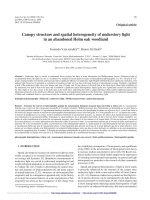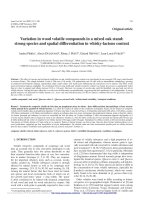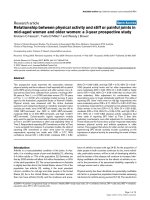Women and mental rotation incremental theory and spatial strategy use enhance performance
Bạn đang xem bản rút gọn của tài liệu. Xem và tải ngay bản đầy đủ của tài liệu tại đây (108.06 KB, 3 trang )
Personality and Individual Differences 46 (2009) 187–191
Contents lists available at ScienceDirect
Personality and Individual Differences
journal homepage: www.elsevier.com/locate/paid
Women and mental rotation: Incremental theory and spatial strategy use
enhance performance
Angelica Moè a,*, Chiara Meneghetti a, Mara Cadinu b
a
b
Department of General Psychology, University of Padua, Via Venezia 8, 35131 Padova, Italy
Department of Developmental and Social Psychology, University of Padua, Italy
a r t i c l e
i n f o
Article history:
Received 27 June 2008
Received in revised form 23 September
2008
Accepted 30 September 2008
Available online 7 November 2008
Keywords:
Stereotyped attitudes
Gender beliefs
Mental rotation
a b s t r a c t
Mental rotation is a spatial skill in which men outperform women. The present research tested a motivational explanation of this gender difference with the hypothesis that positive beliefs will in women
favor use of spatial strategies, which in turn will lead to improved MRT performance. Spatial strategy
use and two beliefs, namely incremental theory and self-perception of ability in stereotypically masculine
(i.e., requiring spatial ability) tasks, were assessed in a sample of 120 women. Two groups of solvers – one
spatial, one non-spatial – were selected on the basis of self-rated strategy use. Results demonstrated that
use of spatial strategies mediates the effect of incremental theory of masculine tasks on MRT performance, whereas self-perception of ability directly influences MRT performance. Findings are discussed
on the basis of a socio-cognitive explanation of gender differences in mental rotation.
Ó 2008 Elsevier Ltd. All rights reserved.
The ability to mentally retain an object and rotate it in space is
termed mental rotation. This ability is associated with success in
topics such as geometry, mathematics, chemistry and physics
(Delgrado & Prieto, 2004), and is important for everyday spatial
activities such as orientation in unfamiliar places or finding a route
on a map (e.g., Linn & Petersen, 1986).
An instrument largely used to assess this ability is the Mental
Rotation Test (MRT; Vandenberg & Kuse, 1978), involving comparison of three-dimensional figures (assembled cubes). The test consists of presentation of a 3D target object, followed by four similar
objects differing in degree of rotation or as mirror images. Test participants are required to identify the two figures that are identical
to the target but rotated in three-dimensional space. Twenty separate target objects are presented, in succession. Typically, in
MRT men score up to one standard deviation higher than women
(e.g., Voyer, Voyer, & Bryden, 1995). This is one of the robust gender differences observed in spatial tasks, with large effect size for
the paper-and-pencil test (Cohen d = 0.88) and medium (d = 0.45)
for the computerized version (Monahan, Harke, & Shelley, 2008).
In other spatial abilities, such as navigation, memory, orientation,
visualization, perception, there is no gender difference (e.g. spatial
visualization, Linn & Petersen, 1985) or women can perform better
than men (e.g. object location memory, Postma, Izendoorn, & De
Haan, 1998). Generally, men outperform in tasks requiring encoding and/or retrieval of metric properties, geometric information or
* Corresponding author. Tel.: +39 049 8276689; fax: +39 049 8276600.
E-mail address: (A. Moè).
0191-8869/$ - see front matter Ó 2008 Elsevier Ltd. All rights reserved.
doi:10.1016/j.paid.2008.09.030
the use of cardinal direction, while females excel in tasks requiring
landmark knowledge or processing (e.g., Iachini, Sergi, Ruggiero, &
Gnisci, 2005).
Many suggestions have been put forward to explain gender differences in mental rotation: hormonal, cultural, practice on the
task, strategic, motivational. From prenatal life, the fetus is exposed to various kinds of gender-related hormones, which are
known to affect brain development and organization (e.g., Burton,
Henninger, & Hafetz, 2005). Activational effects due to the level of
circulating testosterone (3–10 times higher in men than in women)
have also been documented (Yen, Jaffe, & Barbieri, 1999). However,
results obtained are mixed and cannot explain the entire variance
(e.g., Hooven, Chabris, Ellison, & Kosslyn, 2004): further explanations are needed for the differences observed.
In Western cultures, people consider spatial ability as a predominantly masculine characteristic (Devlin, 2001) and encourage boys more strongly than girls to engage in activities that
promote the development of spatial skills (e.g., computer games,
math and science courses). In non-Western cultures (e.g., preliterate Indians of the Ecuador) women outperform men in a variety
of spatial tests (Pontious, 1991). This suggests that one factor
facilitating high mental rotation performance is practice with spatial tasks.
How does greater expertise lead to better results? One relevant
aspect is the kind of strategies used. MRT may be performed using
either holistic or analytical strategies (Linn & Petersen, 1985). The
former involve parallel processes and consist in mentally rotating
the whole figure (target) until it matches the answer choices
and/or mentally rotating the answer choices until they fit the
188
A. Moè et al. / Personality and Individual Differences 46 (2009) 187–191
target. Instead, analytical strategies are based mainly on verbal
processes, such as counting the cubes, and are less effective and require longer execution times than holistic approaches. On average,
women tend to use analytical strategies, while men favor holistic
strategies (e.g., Hugdahl, Thomsen, & Ersland, 2006) and these different approaches may partly explain gender differences in both
accuracy and speed. In fact, women increase MRT performance if
additional time is allowed and if trained with spatial tasks. However, providing additional time does not always reduce the gender
gap (e.g., Peters, 2005), while training is more effective for women
than men (e.g., Feng, Spence, & Pratt, 2007). This suggests the
importance of practice with spatial tasks as a way to improve the
strategic approach.
What factors are encouraging women’s engagement in masculine and spatial tasks? Here, beliefs may play an important role. Research has highlighted the importance of socio-cultural
stereotypes and the way abilities are conceived – that is, as aspects
that cannot be modified or else as characteristics that can be improved through effort and learning (Dweck, 1999). A positive stereotype message (Moè & Pazzaglia, 2006; Wraga, Duncan, Jacobs,
Helt, & Church, 2006) increases women’s performance in spatial
tasks, as do instructions consistent with gender-role beliefs
(Massa, Mayer, & Bohon, 2005) and use of human figures rather
than block stimuli (Alexander & Evardone, 2008). Shaping an incremental theory (Aronson, Fried, & Good, 2002), self-affirming
(Martens, Johns, Greenberg, & Schimel, 2006) or priming a
positive-performance social identity (McGlone & Aronson, 2006)
are ways to maintain self-integrity that helps women perform at
the same level as men.
These studies all suggest that women who believe it is possible
to improve in masculine tasks, i.e. who have an incremental theory
of masculine tasks, should be more motivated to engage in spatial
tasks and discover the best strategies for good performance. Selfperception of ability of masculine tasks – i.e., self-evaluation about
personal perceived ability to handle a task – can also make a difference. The greater the amount of practice with specific tasks, the
higher the self-perception of ability to handle them. Flaberty
(2005), after confirming that men prefer practice with masculine
activities and women with feminine ones, found a positive correlation between the number of masculine activities performed (e.g.,
carpentry, making/fixing a radio, building train/car set) and MRT
scores, irrespective of gender. Women who have practiced a large
number of masculine tasks should have developed a higher selfperception of ability in spatial tasks and consequently perform better in MRT than women who have less practice (e.g., Casey, Nuttall,
& Pezaris, 1997).
In the present research, we test the effects of beliefs and use of
spatial strategies on MRT performance. First, we predict confirmation that higher spatial strategy use correlates with good MRT performance. Second, we test the effects of beliefs in incremental
theory and self-perception of ability of masculine tasks on MRT
performance. We expect to find that higher incremental theory
and self-perception of ability of masculine tasks corresponds to
better MRT performance. Third, more importantly, we test the
mediation role of spatial strategy use in MRT performance. We explore whether spatial strategy use mediates the effect of beliefs on
MRT performance. Two models are tested with predictor variables
incremental theory of masculine tasks (first model) and self-perception of ability of masculine tasks (second model). The mediator
(spatial strategy use) and the dependent variable (MRT performance) are the same in both models. Our hypothesis is that incremental theory women would be more likely to use strategic
behaviors and therefore reach good performance, and that women
who perceive they can tackle masculine tasks would be more likely
to adopt the most effective strategies to undertake spatial tasks,
and hence increase MRT performance.
1. Method
1.1. Participants
One hundred and twenty female undergraduates were recruited
on a voluntary basis during one particular general psychology
class, and allowed extra course credit for participation in the research. Mean age was 21.24 years (SD = 2.40). Institutional ethics
approval was given for the study.
1.2. Materials
1.2.1. Beliefs questionnaire
We devised an instrument listing 15 cognitive tasks selected
through previous research (Moè & Pazzaglia, 2006) as stereotypically masculine (solving math problems, engaging in a new sport,
finding a route on a map, finding the quickest way to reach a place,
building or repairing something), feminine (e.g., learning a foreign
language, feeling others’ emotions) or neutral (e.g., paying attention during a lecture, being curious to learn new things). Participants were asked to give three ratings for each of the 15 listed
tasks: gender stereo-typicality, incremental theory, and self-perception of ability. The questions were (a) ‘How much do you think
that men differ from women in each of the following tasks?’ rating
from ‘À3’ = ‘women much better’ to ‘+3’ = ‘men much better’; (b)
‘How much can a person improve in each of the following tasks?’
rating from ‘1’ = ‘not at all’ to ‘7’ = ‘very much’; (c) ‘How good do
you think you are in the following tasks?’ rating from ‘1’ = ‘not at
all’ to ‘7’ = ‘very much’.
1.2.2. Mental rotation test (MRT)
A computerized 10-item modified version of MRT of the original
test of Vandenberg and Kuse (1978) was used (Moè & Pazzaglia,
2006). Items were composed of a target and four test stimuli, each
3.5 Â 3.5 cm. The task was to identify the two figures identical to
the target but rotated in three-dimensional space. Cronbach alpha
was 0.86.
1.2.3. Strategy questionnaire
We devised a questionnaire to assess the strategies employed to
solve MRT items, divided into holistic strategy – ‘‘I rotated the target-stimulus to match the test-stimulus” (item 1), ‘‘I rotated the
test-stimulus to match the target-stimulus” (item 2), ‘‘I globally rotated the stimulus” (item 4) and ‘‘I imagined myself rotating
around the object” (item 6); or analytical – with a typical verbal
strategy ‘‘I counted the cubes” (item 3) and a sequential strategy
‘‘I rotated the stimulus piece by piece” (item 5). Participants were
asked to rate how much they used each strategy, on a Likert scale
ranging from ‘1’ = ‘not at all’ to ‘7’ = ‘very much’.
1.3. Procedure
Participants were individually tested. They first completed the
Beliefs Questionnaire without time limit, and then performed the
MRT. Proceeding in this order evokes concern in belief in ability
or inability and perhaps performance apprehension and stereotype
threat in all participants, thus stressing the motivational aspects in
performing a typical masculine task. In contrast, submitting the beliefs questionnaire after performing the MRT should have influenced perceived performance (low or high), as stated in the
beliefs questionnaire.
Participants initially read the instructions and had training with
three practice items. They were told that the test they were performing was being timed, and should be completed within 4 min.
From this they could have inferred the need to work as quickly as









